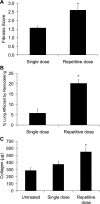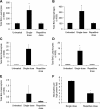Repetitive intratracheal bleomycin models several features of idiopathic pulmonary fibrosis
- PMID: 20562227
- PMCID: PMC2957416
- DOI: 10.1152/ajplung.00026.2010
Repetitive intratracheal bleomycin models several features of idiopathic pulmonary fibrosis
Abstract
Single-dose intratracheal bleomycin has been instrumental for understanding fibrotic lung remodeling, but fails to recapitulate several features of idiopathic pulmonary fibrosis (IPF). Since IPF is thought to result from recurrent alveolar injury, we aimed to develop a repetitive bleomycin model that results in lung fibrosis with key characteristics of human disease, including alveolar epithelial cell (AEC) hyperplasia. Wild-type and cell fate reporter mice expressing β-galactosidase in cells of lung epithelial lineage were given intratracheal bleomycin after intubation, and lungs were harvested 2 wk after a single or eighth biweekly dose. Lungs were evaluated for fibrosis and collagen content. Bronchoalveolar lavage (BAL) was performed for cell counts. TUNEL staining and immunohistochemistry were performed for pro-surfactant protein C (pro-SP-C), Clara cell 10 (CC-10), β-galactosidase, S100A4, and α-smooth muscle actin. Lungs from repetitive bleomycin mice had marked fibrosis with prominent AEC hyperplasia, similar to usual interstitial pneumonia (UIP). Compared with single dosing, repetitive bleomycin mice had greater fibrosis by scoring, morphometry, and collagen content; increased TUNEL+ AECs; and reduced inflammatory cells in BAL. Sixty-four percent of pro-SP-C+ cells in areas of fibrosis expressed CC-10 in the repetitive model, suggesting expansion of a bronchoalveolar stem cell-like population. In reporter mice, 50% of S100A4+ lung fibroblasts were derived from epithelial mesenchymal transition compared with 33% in the single-dose model. With repetitive bleomycin, fibrotic remodeling persisted 10 wk after the eighth dose. Repetitive intratracheal bleomycin results in marked lung fibrosis with prominent AEC hyperplasia, features reminiscent of UIP.
Figures







Comment in
-
Bleomycin revisited: towards a more representative model of IPF?Am J Physiol Lung Cell Mol Physiol. 2010 Oct;299(4):L439-41. doi: 10.1152/ajplung.00258.2010. Epub 2010 Jul 30. Am J Physiol Lung Cell Mol Physiol. 2010. PMID: 20675435 No abstract available.
Similar articles
-
TGFβ signaling in lung epithelium regulates bleomycin-induced alveolar injury and fibroblast recruitment.Am J Physiol Lung Cell Mol Physiol. 2011 Jun;300(6):L887-97. doi: 10.1152/ajplung.00397.2010. Epub 2011 Mar 25. Am J Physiol Lung Cell Mol Physiol. 2011. PMID: 21441353 Free PMC article.
-
Intratracheal bleomycin causes airway remodeling and airflow obstruction in mice.Exp Lung Res. 2012 Apr;38(3):135-46. doi: 10.3109/01902148.2012.658595. Exp Lung Res. 2012. PMID: 22394287 Free PMC article.
-
Contribution of epithelial-derived fibroblasts to bleomycin-induced lung fibrosis.Am J Respir Crit Care Med. 2009 Oct 1;180(7):657-65. doi: 10.1164/rccm.200903-0322OC. Epub 2009 Jun 25. Am J Respir Crit Care Med. 2009. PMID: 19556518 Free PMC article.
-
The pathogenesis of bleomycin-induced lung injury in animals and its applicability to human idiopathic pulmonary fibrosis.Exp Lung Res. 2015 Mar;41(2):57-73. doi: 10.3109/01902148.2014.979516. Epub 2014 Dec 16. Exp Lung Res. 2015. PMID: 25514507 Review.
-
Emerging evidence for endoplasmic reticulum stress in the pathogenesis of idiopathic pulmonary fibrosis.Am J Physiol Lung Cell Mol Physiol. 2012 Apr 15;302(8):L721-9. doi: 10.1152/ajplung.00410.2011. Epub 2012 Jan 27. Am J Physiol Lung Cell Mol Physiol. 2012. PMID: 22287606 Free PMC article. Review.
Cited by
-
IL-37 protects against airway remodeling by reversing bronchial epithelial-mesenchymal transition via IL-24 signaling pathway in chronic asthma.Respir Res. 2022 Sep 13;23(1):244. doi: 10.1186/s12931-022-02167-7. Respir Res. 2022. PMID: 36100847 Free PMC article.
-
EMT and interstitial lung disease: a mysterious relationship.Curr Opin Pulm Med. 2012 Sep;18(5):517-23. doi: 10.1097/MCP.0b013e3283566721. Curr Opin Pulm Med. 2012. PMID: 22854509 Free PMC article. Review.
-
Interstitial lung diseases-can pathologists arrive at an etiology-based diagnosis? A critical update.Virchows Arch. 2013 Jan;462(1):1-26. doi: 10.1007/s00428-012-1305-0. Epub 2012 Dec 7. Virchows Arch. 2013. PMID: 23224047 Free PMC article. Review.
-
Bimodal fibrosis in a novel mouse model of bleomycin-induced usual interstitial pneumonia.Life Sci Alliance. 2021 Nov 2;5(1):e202101059. doi: 10.26508/lsa.202101059. Print 2022 Jan. Life Sci Alliance. 2021. PMID: 34728556 Free PMC article.
-
AAV9-Tspyl2 gene therapy retards bleomycin-induced pulmonary fibrosis by modulating downstream TGF-β signaling in mice.Cell Death Dis. 2023 Jun 30;14(6):389. doi: 10.1038/s41419-023-05889-8. Cell Death Dis. 2023. PMID: 37391440 Free PMC article.
References
-
- American Thoracic Society Idiopathic pulmonary fibrosis: diagnosis and treatment. International consensus statement. American Thoracic Society and the European Respiratory Society. Am J Respir Crit Care Med 161: 646–664, 2000 - PubMed
-
- American Thoracic Society/European Respiratory Society International Multidisciplinary Consensus Classification of the Idiopathic Interstitial Pneumonias. Am J Respir Crit Care Med 165: 277–304, 2002 - PubMed
-
- Bonniaud P, Margetts PJ, Ask K, Flanders K, Gauldie J, Kolb M. TGF-beta and Smad3 signaling link inflammation to chronic fibrogenesis. J Immunol 175: 5390–5395, 2005 - PubMed
-
- Bonniaud P, Margetts PJ, Kolb M, Haberberger T, Kelly M, Robertson J, Gauldie J. Adenoviral gene transfer of connective tissue growth factor in the lung induces transient fibrosis. Am J Respir Crit Care Med 168: 770–778, 2003 - PubMed
Publication types
MeSH terms
Substances
Grants and funding
LinkOut - more resources
Full Text Sources
Other Literature Sources
Molecular Biology Databases
Research Materials
Miscellaneous

